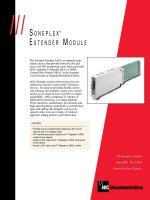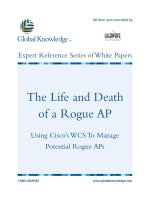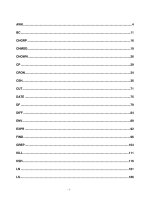Tài liệu Checklist Quick Reference pdf
Bạn đang xem bản rút gọn của tài liệu. Xem và tải ngay bản đầy đủ của tài liệu tại đây (109.17 KB, 10 trang )
This is the Title of the Book, eMatter Edition
Copyright © 2002 O’Reilly & Associates, Inc. All rights reserved.
123
Appendix A
APPENDIX A
Checklist Quick Reference
You can use this checklist in two ways. First, you can use it as a checklist when
securing your routers. You can also use the checklist as the basis for auditing the
security of your routers.
Hardening Your Routers
If you are using this checklist to harden your routers, a good approach is to use the
following three-step process:
1.
Use the checklist to determine your routers’ current security level. Check off
each item that has already been taken care of.
2.
Review all items in the checklist that have not been checked off. For each item,
determine how you are going to address that issue—secure it, leave it alone and
accept the risk, or assign the risk to someone else (e.g., insurance).
3.
Secure each item that you determined needs securing. For all other items, docu-
ment why you are leaving this item unsecured. It is important to list the risks
associated with the item and determine why the risk can be ignored or how it is
being assigned to someone else.
For example, if your network has two routers and one administrator, the cost associ-
ated with setting up an AAA server is probably not justifiable. Local usernames and
passwords would be much more reasonable. Documenting these decisions and get-
ting management to sign off on them helps to cover your tail when an incident occurs.
Auditing Your Routers
Auditing is a topic for a book unto itself and generally requires a higher skill level
than hardening. When hardening a router, a sysadmin can usually turn off services
that aren’t understood. An auditor, however, must understand not only how each
service works, but also the risks associated with that service. For those who are not
,appa.22314 Page 123 Friday, February 15, 2002 2:51 PM
This is the Title of the Book, eMatter Edition
Copyright © 2002 O’Reilly & Associates, Inc. All rights reserved.
124
|
Appendix A: Checklist Quick Reference
just hardening their routers, but auditing them, this checklist can serve as the foun-
dation for an audit of Cisco router security. For those new to auditing, here is an
overview of the typical auditing process:
Securing approval to perform the audit
When performing an audit, make sure you have not only the approval, but also
the authority, to perform the audit. Without approval and authority the best-
case scenario is an incomplete and useless audit. Since many security audits can
look like attacks, the worst-case scenario is your termination or incarceration.
Planning the audit
Make sure that the scope and focus of the audit are defined and agreed upon.
This is the time to define what resources will be needed for the audit, how the
audit will be performed, and what the deliverables will be.
Performing the audit
Performing the audit usually takes two very different steps. First, interviews are
done with everyone involved with items being audited. For a router, this might
include managers responsible for overseeing the router administrators, the infor-
mation security officer of the organization, the senior network administrator, the
junior sysadmins responsible for day-to-day maintenance, and, depending on
where the router is located, janitors or computer operations personnel who have
access to the room the router is in. Second, the router must be audited techni-
cally. The technical audit is when you analyze router configurations and possi-
bly perform penetration testing against the organization’s routers.
Reporting the audit
The report details the findings of the audit and highlights the strengths and
weaknesses discovered in the audit. Circulation of security audit reports should
be restricted since they probably contain vulnerability information.
Following up the audit
Finally, the organization that receives the audit report should review the report
and, for each weakness uncovered, take action to correct the weakness, decide
that the weakness is considered an acceptable risk and live with it, or assign the
risk to a third party with outsourcing or insurance.
Here are some standard points that are key to performing an effective audit:
Independence
The ideal auditor is usually a third party with no vested interest in the outcome
of the audit. When network administrators audit their own networks, it becomes
too easy to selectively ignore certain weaknesses. Also, many managers seem to
see a direct correlation between how much they pay for information and how
much they believe it. Independent audits can often open management’s eyes to
the problems that insiders can’t push politically. This can often help administra-
tors get the resources they really need.
,appa.22314 Page 124 Friday, February 15, 2002 2:51 PM
This is the Title of the Book, eMatter Edition
Copyright © 2002 O’Reilly & Associates, Inc. All rights reserved.
Cisco Router Security Checklist
|
125
Competence
An auditor must be competent to perform the audit. Auditors need the skills and
knowledge to understand how administrators interact with their routers and to
unravel all the nuances of Cisco router configuration files.
Ethics
In security, ethics is always very high on the list of requirements. Since the pur-
pose of auditing is to uncover weakness and vulnerabilities, an auditor must
have impeccable ethics, both personally and professionally.
Due diligence
Auditors must not only have the knowledge to perform the audit, but also must
be able to demonstrate and document that they performed their work to a profes-
sionally acceptable level. The auditor must be competent and must also under-
stand professional auditing standards to the point at which an audit by a different
professional would not uncover significant omissions in the original audit. A
knowledgeable but lazy auditor can do more harm than good.
Finally, many audits are performed to test compliance with existing security policies.
The following checklist can be very useful in establishing or updating these policies.
Cisco Router Security Checklist
This section provides a complete list of the checklists shown at the end of most chap-
ters. It is only a guideline; you don’t have to agree with or implement each of the rec-
ommendations. If the checklist gets you to think about and address each issue, it has
served its purpose. As an administrator, you are responsible for working with man-
agement, determining how much risk your organization can handle, and knowing
how secure your routers need to be.
IOS Security (Chapter 2)
• Make sure that all routers are running a current IOS.
• Make sure that the IOS version is in General Deployment (unless all risks with
the non-GD IOS version have been addressed).
• Check the IOS version against existing Cisco Security Advisories.
• Regularly check Cisco Security Advisories for IOS vulnerabilities.
Basic Access Control (Chapter 3)
• Secure physical access to the router. (See Appendix B).
• Secure console access with the login and password commands.
• Disable or secure AUX access with the login and password commands.
• Disable or secure all VTY access with the login and password commands.
,appa.22314 Page 125 Friday, February 15, 2002 2:51 PM
This is the Title of the Book, eMatter Edition
Copyright © 2002 O’Reilly & Associates, Inc. All rights reserved.
126
|
Appendix A: Checklist Quick Reference
• Do not use the no login command under any line (con/aux/vty) configurations.
• Set the enable password using the enable secret command.
• In organizations in which multiple administrators access a router, enable
accountability by requiring administrators to have separate accounts to access
the router. This can be accomplished through local usernames or more central-
ized methods involving network access servers.
• Do not use TACACS and Extended TACACS in favor of TACACS+, RADIUS, or
Kerberos.
• If any version of TACACS is used for user-level authentications, set the method
of last resort to the privileged password (set with enable secret) and not to
default to open access with no authentication.
• Do not use standard TACACS for privileged-level access.
• If any version of TACACS is used for the enable password—privileged-level
access—then set the method of last resort to the enable secret password and not
to automatically succeed.
• Make sure the router does not use TFTP to automatically load its configuration
at every reboot. If it must, then harden and secure the TFTP server.
• Do not configure the router to serve as a TFTP server.
• With dial-up access to the router, make sure both the AUX port and the modem
are password protected.
• With dial-up access to the router, configure callback security to a predefined
number, or make sure the telephone company uses a closed user group to
restrict which numbers are allowed to call your modems.
• Never connect a modem to the console port.
• Disable reverse Telnet to all physical ports.
• Disable Telnet in favor of SSH on all VTY lines.
• If insecure protocols such at Telnet or HTTP must be used, use IPSec to encrypt
all vulnerable traffic.
• Make sure all VTY access uses ACLs to restrict access to a few secured IPs.
• Set the exec-timeout on all VTYs to five minutes or less.
• Enable the global command service tcp-keepalives-in.
• Disable HTTP access to the router.
• If HTTP access must be used:
— Limit its use to secure networks.
— Only use it over IPSec.
— Restrict access with ACLs to a few secured IPs.
— Change the HTTP authentication method from the default enable password.
,appa.22314 Page 126 Friday, February 15, 2002 2:51 PM
This is the Title of the Book, eMatter Edition
Copyright © 2002 O’Reilly & Associates, Inc. All rights reserved.
Cisco Router Security Checklist
|
127
Password Security (Chapter 4)
• Enable service password-encryption on all routers.
• Set the privileged-level (level 15) password with the enable secret command and
not with the enable password command.
• Make sure all passwords are strong passwords that are not based on English or
foreign words.
• Make sure each router has different enable and user passwords.
• Keep backup configuration files encrypted on a secure server.
• Access routers only from secure or trusted systems.
• In large organizations with numerous personnel with router access, use addi-
tional privilege levels to restrict access to unnecessary commands.
• Reconfigure the connect, telnet, rlogin, show ip access-lists, show access-lists, and
show logging commands to privilege level 15.
AAA Security (Chapter 5)
• If AAA is used, when possible, use TACACS+ instead of other methods.
• If TACACS+ or RADIUS is used, then keep the configuration files secure, since
TACACS+ and RADIUS keys are not obscured by the service password-
encryption command.
• If AAA authentication is used, always set the backup method for authentication to
locally configured usernames or the default privileged password and never to none.
• If AAA authorization is used and your security needs are low to medium, make
sure the backup method for authorization is if-authenticated (to avoid being
locked out of the router).
• If AAA authorization is used and you need a higher level of security, make sure
there is no backup method for authorization.
• Disable HTTP access. If it must be used, make sure it uses TACACS+ or
RADIUS, and not the default privileged-mode password, for authentication.
• In larger organizations that need dual-factor access control, configure the
router’s TACACS+ or RADIUS servers to use token-based access control.
Warning Banners (Chapter 6)
• Make sure every router has an appropriate warning banner that includes word-
ing that states:
— The router is for authorized personnel only.
— The router is for official use only.
,appa.22314 Page 127 Friday, February 15, 2002 2:51 PM









